There are certain recipes that I’ll always keep chasing and these round skillet breads filled with green onion and sesame oil is one of them. I first had them in Monterey Park in the late 1980s. My friend, Teresa C., took me to dinner at a Chinese-Islamic Restaurant (I think that that was its name), a new and novel concept.
Teresa and I met while attending business school at the University of Southern California and our conversation quickly turned from finance and accounting to food. Teresa’s father managed Chinese restaurants in Monterey Park. She and her family were from Hong Kong and they knew where the good Chinese food was in the San Gabriel Valley, located east of Los Angeles. They were in on the ground level of what today is arguably the best source of Chinese food in America.
Lamb stir-fried with green onions and the restaurant’s sesame bread (zhima dabing in Mandarin) were my major takeaways from that eating experience. I stuffed the lamb into the bread. I used the bread to wipe and mop up extra sauces and such on my plate. It was novel and new to me because I wasn't fully aware of the bread culture in northwest and northern China. I was smitten, to say the least.
Ever since then, I’ve been trying to make the bread at home. I’ve tried many recipes, including one from Barbara Tropp’s classic book and instructions found online. Last year Bon Appetit had a recipe from Parachute restaurant in Chicago but it was so restaurant-fussed up that I skipped it.
The dough is tricky because it has to be soft-chewy and leavened enough to cook up in a skillet. Ovens are not a traditional Chinese cooking appliance yet cooks have developed wonderful bread and cakes using woks, skillets, and steamers.
Carolyn Phillips’s new and practically encyclopedic cookbook, All Under Heaven: Recipes from the 35 Cuisines of China, offered some insights. This is great book for people who want to dive deep into Chinese cooking and traditions. There’s a recipe for fermented red tofu, for example! And there are simple recipes too, like eggs and tomato. Carolyn lived in Taiwan for many years and is married to a Taiwanese man. They are very committed to exploring and explaining Chinese foodways.
For many of the doughy recipes, Carolyn suggested blending unbleached all-purpose and unbleached pastry flour in a 2:1 ratio to mimic the moderate gluten level of all-purpose Chinese-style flour. I often use Gold Medal unbleached or bleached all-purpose flour for my Asian dumplings and breads so I was interested to try her approach.
Seeing as how this was my first time out, I had a few challenges. My dough was earlobe soft and tacky like a Post-It note. I was using White Lily unbleached all-purpose and health food market pastry flour; next time, I’ll stick with Gold Medal for the all-purpose flour. I didn’t get the perfect round shape that I’d experienced at Chinese restaurants. Carolyn illustrated the entire book and I could see from the one-page recipe layout that there was no space to illustrate how the dough was shaped. I got the idea enough from her instructions and my past experiences with Chinese doughs.
At the end when I had to roll the square dough packet into a round, that was challenging. I got an envelope on my first try. Then I stood one the other square on its end and patted it down and got a roundish shape. It was natural for some of the green onion to squirt out the dough so I tossed some flour on the bread and moved on.
I didn’t worry when it was hard to manipulate the dough rounds to get the sesame seeds on the bread. No problem, I kept going and simply sprinkled the sesame on the bread and pressed them into the dough. This wasn’t my first rodeo with this Chinse-Islamic sesame and green onion bread.
To cook the breads, I used a thin nonstick skillet and a cast iron one. Both worked fine, with the cast iron taking longer to heat up. It was great to watch bread cook on the stovetop. Soon enough, the breads were done and I had a lovely mid-day snack.
These are fun to make. If you don’t want to blend flour, try using 2 cups (10 ounces) Gold Medal bleached all-purpose flour or Whole Foods organic unbleached all-purpose flour, which is slightly more tender than Gold Medal’s unbleached all-purpose. On the other hand, just go to health food market’s bulk bin and get the one or two kinds of flour needed. It’s awesome to blend flours to see what happens! You can make these seemingly exotic breads with grocery store ingredients. Do it.
Recipe
Chinese-Islamic Sesame Scallion Bread
Zhima Dabing
Yield: 2 breads to serve 6 to 8
Ingredients
Dough
- ¾ cup warm water
- 1 teaspoon fast-rising dry yeast
- 1 teaspoon sugar
- 1 ⅓ cups (6 ⅝ ounces) unbleached all-purpose flour, such as Gold Medal
- ⅔ cup (2 ⅞ ounces) unbleached pastry flour
- 1 teaspoon peanut or vegetable oil
- 1 teaspoon baking powder
Seasonings
- 2 tablespoons toasted sesame oil
- ¾ teaspoon salt
- ¾ cup finely chopped green onions
- ½ cup raw white sesame seeds
Method
- Place the water in a bowl or cup and sprinkle the yeast and then the sugar on top. Gently mix the yeast into the water and give it about 20 minutes to foam.
- Meanwhile, in a medium work bowl, combine the all-purpose and pastry flour in a bowl. Scoop up ¼ cup and set aside to use later.
- When the yeast mixture is ready, stir it into the flour to form a soft dough. Knead the dough until it no longer sticks to your hands, adding a bit more flour as necessary. Form the dough into a ball. Coat the inside of a clean work bowl with the oil, place the dough in the bowl, cover, and let it rise for 45 to 60 minutes, until doubled in size.
- Sprinkle the baking powder on a smooth work surface. Punch down the dough, form it into a ball, and place it on the baking powder. Knead these together until smooth. When the dough is as soft as an earlobe, cover it and let it rest for around 20 minutes.
- Cut the dough in half and roll each piece into a 10 x 12–inch rectangle shape. Brush the sesame oil all over the surface of both pieces and then evenly sprinkle on the salt and green onions. Fold the top and bottom thirds of each piece over the middle like a business letter. Then fold the left and right sides over the center to form a square packet. Cover the dough and let it rest for about 20 minutes.
- Form each half of the dough into circles by gently rolling them out from the center toward the edge until they are about 8 inches in diameter.
- Pour the sesame seeds into a rimmed dish. Lightly moisten the top of 1 dough circle with water, and then press the circle upside down on top of the sesame seeds. Moisten the other side of the circle and press this side, too, into the sesame seeds. (The bread can be made ahead of time up to this point and frozen. Defrost the bread before cooking it so it can rise properly.) Place 1 circle in a cool, clean, nonstick frying pan and the other on a baking sheet, cover both, and let the dough rise for 15 to 20 minutes.
- Place the pan over medium-low heat, cover, and slowly cook the bread until it is browned on the bottom and the seeds begin to pop, 10 to 15 minutes. Carefully flip the bread over, cover again, and fry the second side until it, too, is golden. Cool on a rack (or slide into a warm oven to keep hot) while you cook the other bread. Cut the bread into wedges and serve. To reheat, recook lightly on both sides or use the toaster oven. This bread is great hot, warm, or at room temperature.
Adapted from Carolyn Phillips’s All Under Heaven (Ten Speed Press, 2016).
Related recipes:
- Bacon and Scallion Pancakes
- Chicken with Black Beans (the bread may be really nice with this)













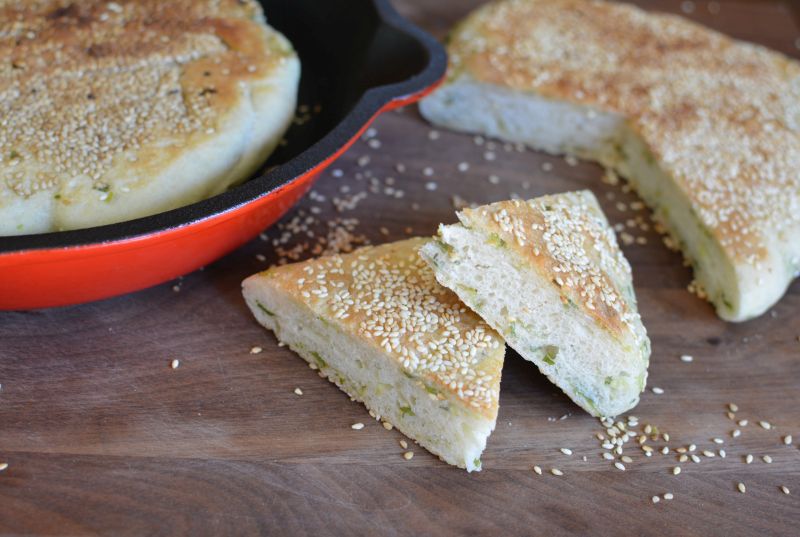

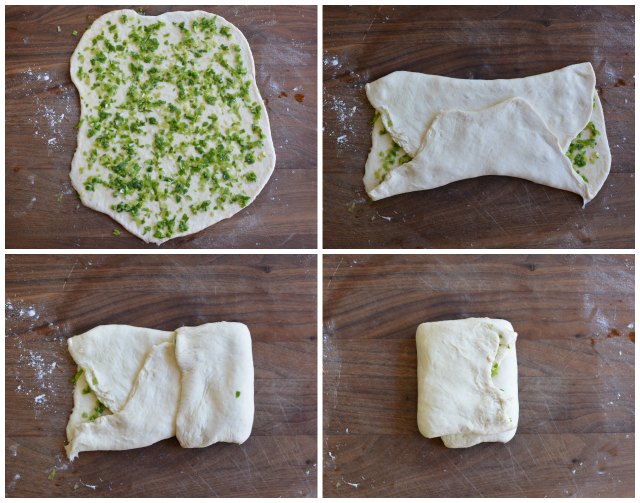
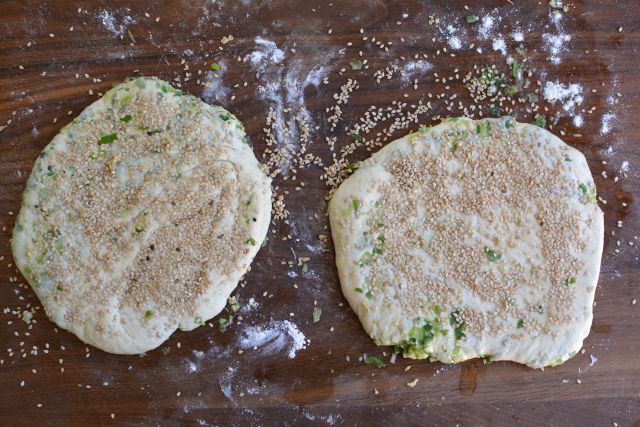
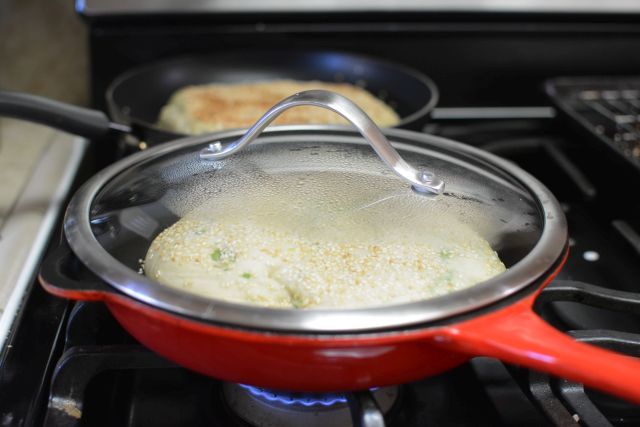



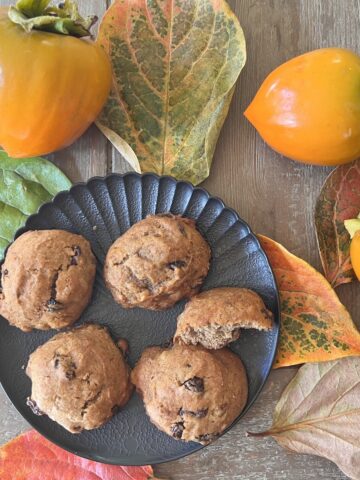
Simone says
Hello! Greetings from Italy! I've found a video recipe of something that looks like your bread and after doing some researches, I've found your site! My most concerns regard the flour, considering any country have a different kind of them... talking about strenght (W) and protein % (data that I think are the only ones that all the flours may share), it's possible to know what they should be to make this bread? Thank you!
To give some examples, a 8gr proteins is a weak flour usable generally for cakes, around 13gr is good for fluffy bread that need to grow in height like shokupan
Andrea Nguyen says
Somewhere in the middle works -- about 11 percent protein. In America, that is considered "all purpose". So no flour for bread for these pancakes!
Andrea Nguyen says
How much soda do you add to the water?
Amy Beth Clark-Downing says
I have been trying to make that bread from that same restaurant!! I am excited to try this.
Andrea Nguyen says
Woohoooo!!! Hope you like it.